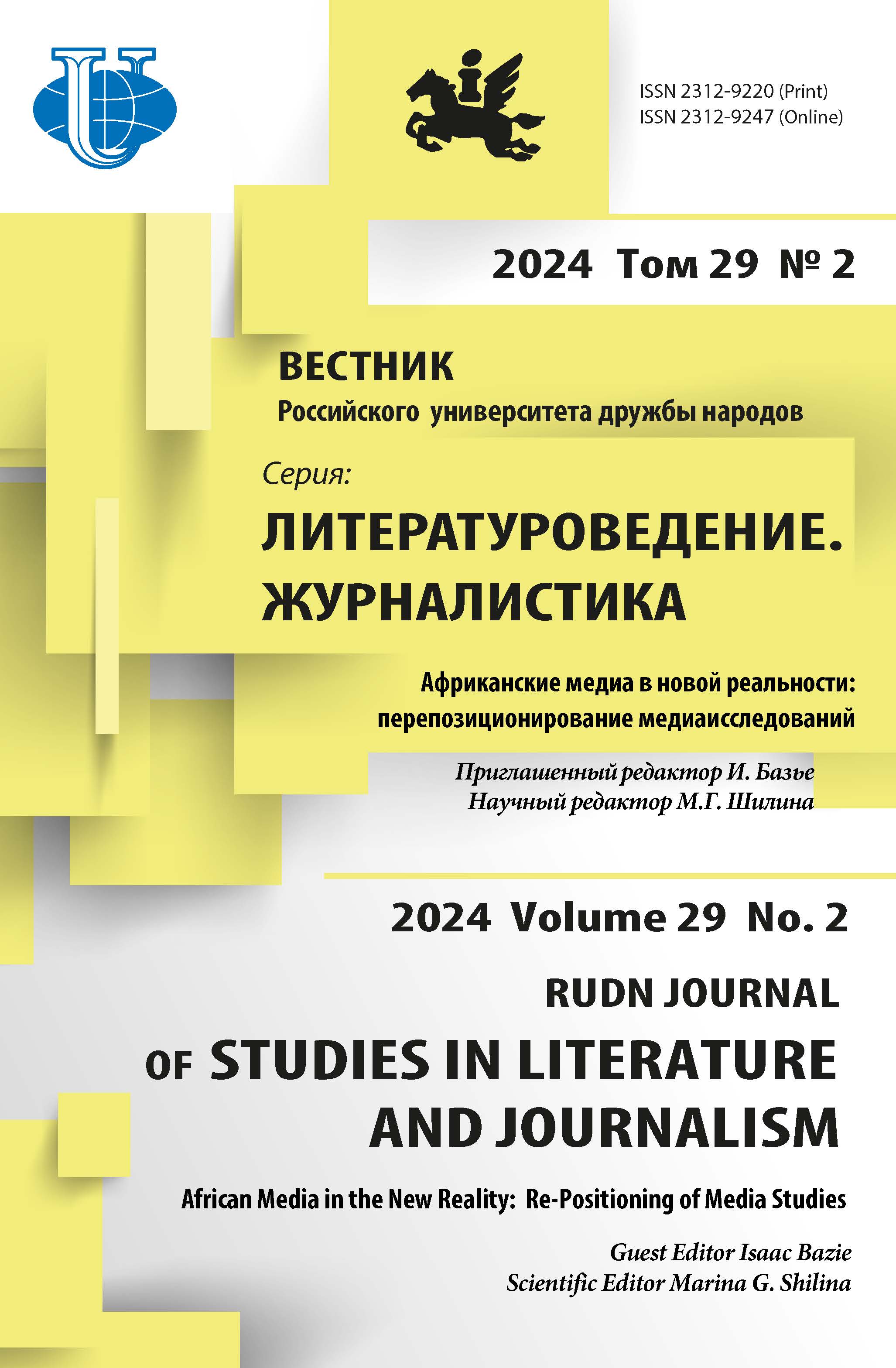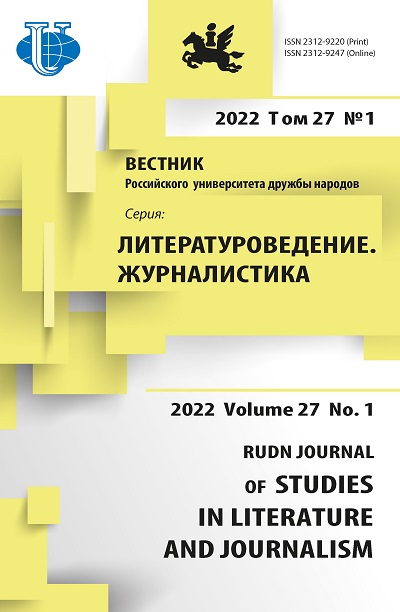The Process of Adapting Content of the Online Newspaper Lenta.ru Towards the Social Media Space
- Authors: Grabelnikov A.A.1, Ye Z.2
-
Affiliations:
- Peoples Friendship University of Russia (RUDN University)
- Lomonosov Moscow State University
- Issue: Vol 27, No 1 (2022)
- Pages: 189-199
- Section: JOURNALISM
- URL: https://journals.rudn.ru/literary-criticism/article/view/30732
- DOI: https://doi.org/10.22363/2312-9220-2022-27-1-189-199
Cite item
Full Text
Abstract
Currently, online newspapers whose activities meet journalistic standards are forced to adapt quite quickly to the rapidly developing digital environment. This is primarily due to the transition of the majority of the readership to the space of social networks and messengers, acting today as “news providers”. In the current situation, media editors have to master new, unusual strategies and technologies for presenting news content. The purpose of the study is to identify the features of the process of transformation of the communication structure of the mass media to the space of social networks and messengers in a changing information environment, using the example of an online newspaper Lenta.ru . This article describes the characteristics of a social network and messenger as platforms for the activities of the online publication. The article examines the ways of presenting the material and the strategies used by the editorial staff on these Internet resources, taking into account the process of merging journalism and marketing, which is characteristic of the media activities in social networks.
About the authors
Alexander A. Grabelnikov
Peoples Friendship University of Russia (RUDN University)
Author for correspondence.
Email: grab@mail.ru
ORCID iD: 0000-0003-1415-824X
Doctor of Historical Sciences, Professor
10 Miklukho-Maklaya St, bldg. 2, Moscow, 117198, Russian FederationZheyuan Ye
Lomonosov Moscow State University
Email: gm_shengye@qq.com
graduate student, Department of New Media and Communication Theory, Faculty of Journalism 9 Mokhovaya St, Moscow, 125009, Russian Federation
References
- Amzin, A.A. (2013). On the reassessment of the importance of new formats in Russian online media. New media in humanitarian education. Sat. articles for the scientific-practical conference (pp. 9–12). Moscow: RSUH. (In Russ.)
- Grabelnikov, A.A. (2013). Features of convergent journalism. Bulletin of the University of the Russian Academy of Education. Philology and Journalism, (3), 79–83. (In Russ.)
- Grabelnikov, A.A. (2011). People’s journalism and social networks. Bulletin of the University of the Russian Academy of Education. Philology and Journalism, (1), 21–26. (In Russ.)
- Grabelnikov, A.A., & Savenkov V.D. (2018). Audience as a subject of civic journalism. Journal of Social and Humanitarian Knowledge, (8), 41–55. (In Russ.)
- Dmitriev, O.A. (2020). Classification of alternative media. RUDN Journal of Studies in Literature and Journalism, 25(3), 567–575. (In Russ.) https://doi.org/10.22363/2312-92202020-25-3-567-575
- Dyachenko, O.V. (2014). Russian mass media in social networks Facebook (Activities on the territory of the Russian Federation are prohibited) and VKontakte: interaction practices. Mediascope, (4). Retrieved from http://www.mediascope.ru/1615 (In Russ.)
- Kosonen, M., & Ellonen, H.-K. (2010). From ivory towers to online bazaars? The internet, social media and competing discourses in the newspaper industry. Knowledge Management Research & Practice, 8(2), 135-145. https://doi.org/10.1057/kmrp.2009.37
- Kruglova, L.A., & Bolotova, E.A. (2020). Content of radio stations Business FM, Vesti FM and Kommersant FM in social media. Vestnik Moskovskogo universiteta. Seriya 10. Zhurnalistika, (3), 56–78. (In Russ.) https://doi.org/10.30547/vestnik.journ.3.2020.5678
- Lazutova, N.M., & Volkova, I.I. (2017). Screen media and human ecology: from enchantment to attachment. Vestnik Orenburgskogo gosudarstvennogo universiteta, 12(212), 106–111. (In Russ.)
- Megele, C., & Buzzi, P. (2020). Social Media and Social Work: Implications and Opportunities for Practice. Bristol: Policy Press.
- Nekliev, S.E. (2010). Infographics: principles of visual journalism. Vestnik Moskovskogo universiteta. Seriya 10. Zhurnalistika, (4), 53–65. (In Russ.)
- Panchenko, E. (2011). Integration of Internet media and social networks in Runet: A new public sphere or a space of control? Digital Symbols: Research in Russian, Eurasian and Central European New Media, (5), 87–88. (In Russ.)
- Panyusheva, M.M. (2010). Blogosphere: traditional media vs non-traditional. Vestnik Moskovskogo universiteta. Seriya 10. Zhurnalistika, (4), 106–122. (In Russ.)
- Sergeeva, Y. Internet and social networks in Russia in 2021 — all statistics. Retrieved October 28, 2021, from: https://www.web-canape.ru/business/internet-i-socseti-v-rossii-v-2021-godu-vsya-statistika/ (In Russ.)
- Shchepilova, G.G. (2014). Demand of the audience in the Internet and traditional media. Vestnik Moskovskogo universiteta. Seriya 10. Zhurnalistika, (5), 45–54. (In Russ.)
- Urazova, S.L. (2019). The media ecosystem in the projection of technological innovations. RUDN Journal of Studies in Literature and Journalism, 24(3), 477–485. (In Russ.) https:// doi.org/10.22363/2312-9220-2019-24-3-477-485
- Van der Haak, B., Parks, M., & Castells, M. (2012). The Future of Journalism: Networked Journalism Rethinking Journalism in the Networked Digital Age. International Journal of Communication, (6), 2923–2938.
- Vartanova, E.L. (2018). On the basic concepts of the «field of digital media» in Russian media research. MediaAlmanach, (2), 8–16. (In Russ.)
- Volkova, I.I., & Budovskaya, Yu.V. (2012). Distribution of media content in social media and social networks: game theory against virality. Bulletin of the Moscow State University of Culture and Arts, (5), 69–74. (In Russ.)
- Volkova, I.I., & Guzhviy, D.A. (2017). An integrative approach to measuring the effectiveness of new media content. RUDN Journal of Studies in Literature and Journalism, 22(3), 532–543. (In Russ.) https://doi.org/10.22363/2312-9220-2017-22-3-532-543
















